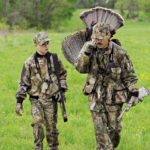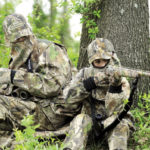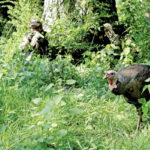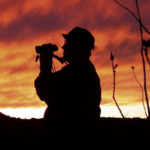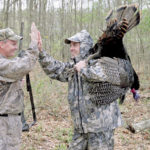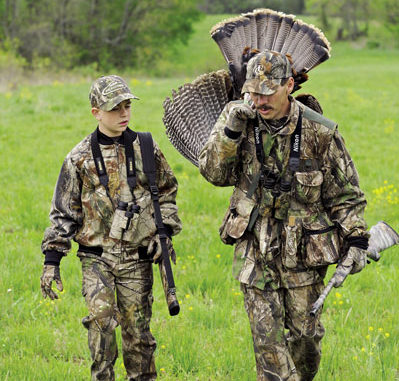
Get your turkey season started off right by visiting one of these WMAs.
When the longbeards start talking to the timber, every Louisiana sportsman concentrates on finding a place to hunt, and lucky for us, the Bayou State has productive public lands.
According to Louisiana Department of Wildlife and Fisheries biologist Randy Myers, the top-five WMAs for bagging a gobbler this season include Red River/Three Rivers, Sherburne, Jackson-Bienville, Fort Polk/Peason Ridge and Sicily Island Hills.
Sherburne WMA
This 44,000-acre WMA, located in the Atchafalaya Basin near Krotz Springs, is a complex of properties combining acreages of lands from Louisiana Wildlife and Fisheries, the U.S. Army Corps of Engineers and the Atchafalaya Wildlife Refuge, which is owned by the U.S. Fish and Wildlife Service, Myers explained. Sherburne is a bottomland hardwood site with food plots, pipelines and other rights of way, where turkeys have plenty of places to strut and mate interspersed throughout the entire WMA.
Hunters can enter a lottery to have a chance to be one of the 150 lucky hunters allowed to hunt Sherburne early for turkeys that have had no hunting pressure. Get as close as you can to the turkey when he’s gobbling from a tree, and try to call him from the tree to the ground close to you. Most hunters probably will hunt the open areas for the easy gobblers.
After the lottery hunters leave, a general open season starts for the first 150 hunters that come to the WMA, and lasts from Monday through Wednesday. If you hunt during the general hunt, get to the WMA early. Assume hunters on the first weekend already have taken many of the easy turkeys, called to all the birds and possibly spooked them.
Set-up as far away from a road as possible. The farther you can get away from any of the roads or the rights of way, the better your odds for locating a gobbling turkey. Call very little, and plan to wait a long time for the gobbler to come in to your stand site. Hunt smart.
“Hurricane Gustav made turkey hunting more difficult at Sherburne and decreased the harvest of gobblers by about 50 percent,” Myers said. “Last season, hunters took about 35 turkeys off Sherburne. Ten years ago, we were harvesting about 60 birds per season.”
The Big Alabama Bayou in the center of the WMA has produced good numbers of turkeys, but hunters can access it only by boat.
“Also, try to call a gobbler off the restricted area on the north side of Sherburne,” Myers recommended.
Red River/Three Rivers WMAs
“These separate wildlife areas adjoin one another, and their bottomland hardwoods provide great opportunities for taking turkeys,” Myers said.
Located at the southern tip of Concordia Parish near the confluence of the Red and Mississippi rivers and where the Atchafalaya River is created, the 30,000-acre Three Rivers WMA and the 42,000-acre Red River WMA create about 70,000 acres of habitat.
These two bottomland hardwood WMAs have numbers of openings. To enhance the habitat for turkeys and create more nesting cover, the state uses some timber management near areas known for holding good numbers of turkeys to provide more nesting sites for hens. This area doesn’t have a lottery system.
“Each season, we harvest 50 to 80 turkeys off these two WMAs,” Myers said. “Anywhere you pinpoint ridges associated with open woods, you’ll generally find productive places to hear turkeys gobble.
“In 2007, 1,300 man days of turkey hunting were recorded, and 87 turkeys were harvested. In 2008, there were 814 man days hunted, and 78 gobblers taken. The turkeys bagged per days hunted on this WMA were from 1:8 days to take a turkey to as much as 1:15 days of effort, which still were very good statistics.”
Jackson-Bienville WMA
This 32,000-plus-acre WMA, located near Ruston in Bienville, Jackson and Lincoln parishes, has more pines than hardwood, Myers explained. Owned by Weyerhaeuser and private landowners, Jackson-Bienville is leased to the state.
“In conjunction with Weyerhaeuser, we conduct controlled burns, set-up food plots and create strategic openings throughout the property,” Myers said. “We also have partnered with the National Wild Turkey Federation to do some habitat-improvement work, particularly on pipeline and power-line rights-of-way. In these sites, we’ve created food plots favorable for turkeys.”
Many hunters avoid hunting turkeys in pine plantations and consider pine plantations biological deserts that won’t support any type of wildlife. However, in recent years, outdoorsmen have learned that numbers of deer and turkeys live inside and on the edges of pine plantations.
For the late-season hunter, hunting in the center of a pine plantation can mean a turkey-hunting bonanza. Most turkey hunters like clean, open woods where they can hear and see turkeys, so that’s where you’ll find the majority of the hunting pressure. Gobblers that have survived the early season have to move into the thick pine plantations where most hunters won’t hunt.
Call a little, wait a lot, and expect to see a gobbler before you hear him on this WMA. Many times you’ll call in and take a gobbler you’ve never heard gobbling by setting up in a pine plantation.
“This WMA has an active management program for the red-cockaded woodpecker,” Myers said. “Management for this woodpecker requires frequent burning that also creates excellent habitat for turkeys, since immediately after the burn, the turkeys can find seeds in the ashes. Then as soon as the young sprouts start up in the spring, turkeys can eat that young vegetation. An early-season turkey hunter needs to look for the fresh burns and listen for gobblers there.”
Fort Polk and Peason Ridge WMAs
Both these WMAs are pine sites owned by the U.S. Army Corps of Engineers and the U.S. Forest Service, Myers said.
“Like Jackson-Bienville, controlled burning is used here as a wildlife-management tool to help improve the habitat for deer, turkey and other wildlife,” Myers said. “Peason Ridge is 33,000 acres, and Fort Polk contains 105,000 acres. Even though these two WMAs aren’t joined, they’re close to one another.
“Hardwoods are along the drainage systems of both these WMAs, and there’s plenty of quality habitat for turkeys.”
Hunters will find certain sections of these two WMAs off-limits because they’re controlled by the military. These off-limit areas create sanctuaries for gobblers, which helps ensure the future of the turkey populations. The U.S. Forest Service land is generally always open.
To successfully hunt and take gobblers at these WMAs, get aerial maps of both properties, and study them carefully. Look for places where most turkey hunters probably will hunt, and mark those off your map. Circle the spots the most difficult to reach, and consider them your target areas. You may need a handheld GPS receiver to move to and from the regions you’ve identified. The hunters who put forth the most effort to hunt these two WMAs will locate and bag their gobblers.
Sicily Island Hills WMA
With 7,500 acres, Sicily Island, one of the smaller WMAs in Louisiana, remains an area that produces good numbers of turkeys consistently.
“Sicily Island Hills WMA is located in the north-central part of the state, and it’s quite a unique habitat,” Myers said. “This upland hardwood/pine site is in the middle of the Mississippi River floodplain. Sicily Island sticks out like a sore thumb. You’ll be riding along in the Delta, looking at cotton land, soybean land and corn land, and then suddenly you start seeing pine trees on the horizon. When you get close to it, you’ll say, ‘Here’s some topography that’s completely out of place.’ Sicily Island is a unique island of habitat in the Boeuf River and the Mississippi River floodplain.”
Surrounded by agriculture, Sicily Island Hills WMA has an abundance of food for the turkeys.
“It is a hilly island in the middle of a floodplain, but there’s no water around it,” Myers said. “The land around it is just delta land. Also, Sicily Island Hills WMA has one of the only waterfalls in Louisiana. Although only about 10 to 15 feet high, this waterfall is fed by a little creek.”
LDWF manages Sicily Island Hills for turkeys through a lottery system.
“The state wants to provide a quality hunt for the sportsmen lucky enough to be drawn in the lottery,” Myers said. “During the last few years, this WMA has produced 12-18 turkeys per season, and the turkeys bagged per hunter effort are from 1:10 to 1:15. There are four lotteries for Sicily Island, and each lottery will allow 30 people to hunt, with a total of 120 individual hunters allowed on the WMA each turkey season.”
This hunt features the opportunity to harvest a really nice bird with many trees for the turkeys to roost in and an abundance of croplands close by. This region can produce and hold far more turkeys per acre than some of the larger WMAs.
